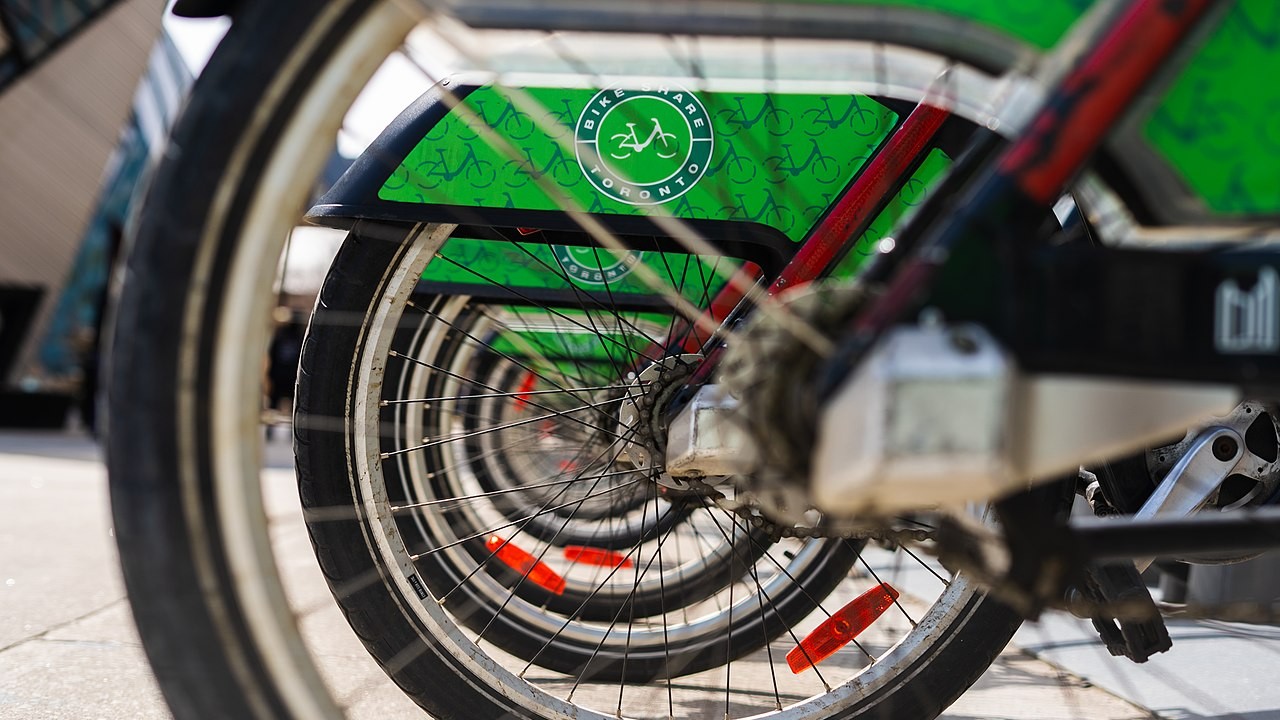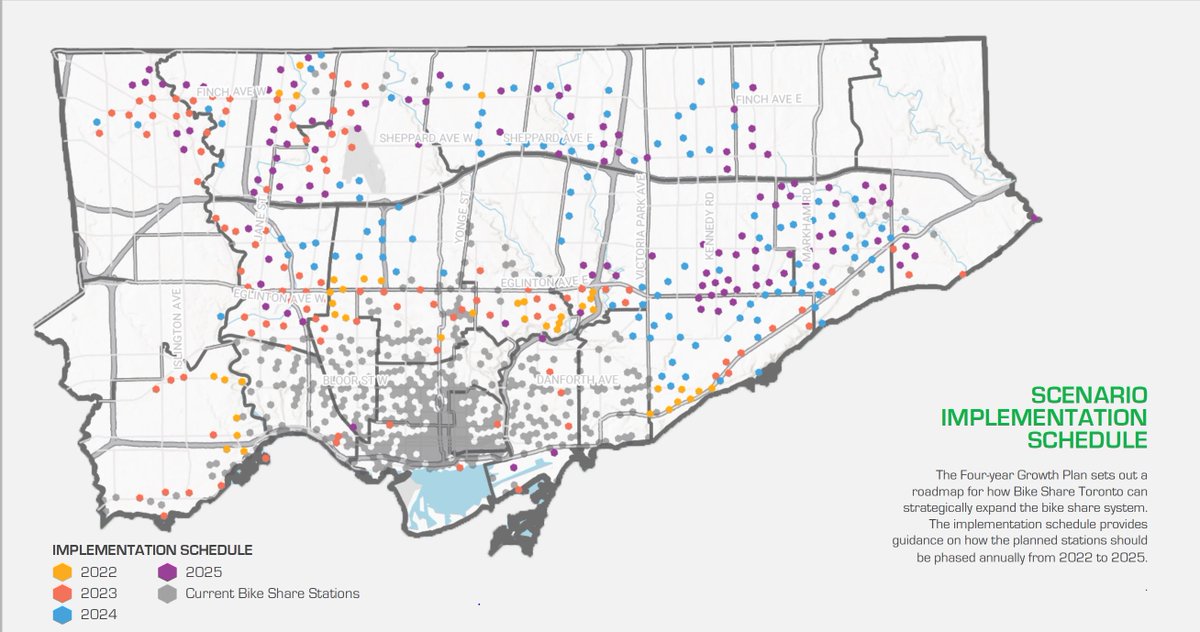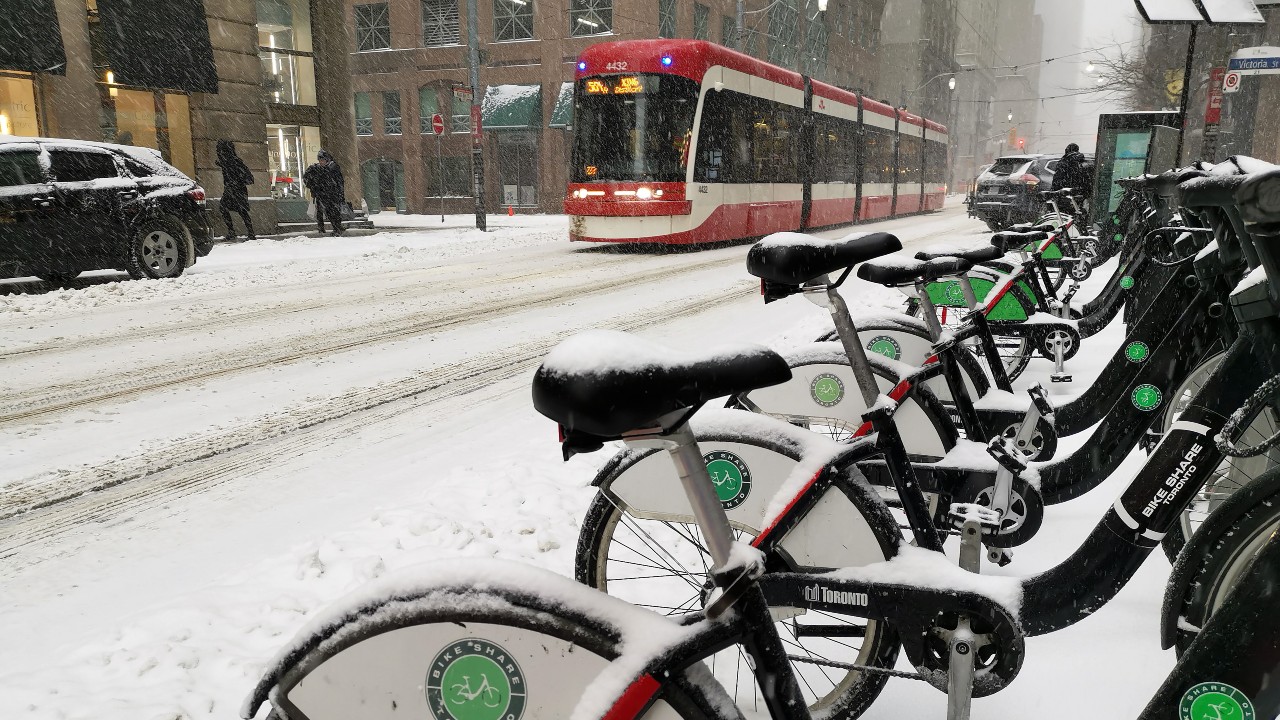Bike Share Toronto is getting a major expansion. Here’s the breakdown.
A four-year growth plan means the system will contain over 1,000 stations and 10,000 bikes by 2025.

Since launching in 2011, Bike Share Toronto has grown to be an integral part of the city’s transit system.
At first, there were only 80 stations, all located in the downtown core along the waterfront. But major changes came when initial owner Bixi went bankrupt in 2014. The city bought up the assets and took the program over, eventually transferring control to the Toronto Parking Authority in 2017.
Today, Bike Share Toronto is North America’s fourth-largest bike share system, boasting 680 stations and over 7,000 bikes — and the expansion has just begun.
Last fall, the program announced a major four-year growth plan that will see it bump up those numbers even more, increase its e-bike fleet, and enter all 25 of the city’s wards by 2025. In more recent days, the City announced Tangerine Bank as the new exclusive presenting partner for the program, a five-year partnership that will support the growth plan through its completion.
What’s the current state of Bike Share Toronto?
According to Bike Share Toronto director Justin Hanna, the program’s popularity shot up during the pandemic.
As people practised social distancing and avoided indoor spaces, many turned to cycling for both exercise and transportation.
“A lot of people discovered Bike Share during the pandemic because they didn’t want to get onto crowded subways or buses or take Ubers, and the outdoors were safer,” said Hanna.
Another factor in Bike Share’s pandemic popularity was ActiveTO, a city-run program that saw major thoroughfares in Toronto be closed to car traffic to make way for pedestrians and cyclists.
“We set up temporary Bike Share stations along ActiveTO routes to allow people to take advantage of the program,” said Hanna.
Ridership boomed thanks in part to these new stations. In 2020, Bike Share counted 2.9 million annual rides, up from 2.4 million the year before.
It was during this period that Bike Share Toronto expansions began in earnest.
“There have been some small expansions [since 2011], but a major expansion happened in 2020 when the system went from 465 stations to 625,” said Hanna.
That year was also when Bike Share introduced electric bikes and began to expand outside of old Toronto.
The ridership growth has continued ever since. In 2021, there were just over 3.5 million annual trips. In 2022, the number hit 4.6 million.
What are the details of the expansion?
Announced in late September, Bike Share’s four-year growth plan includes 375 new stations. The organization will also be adding 3,150 bikes to its fleet.
Work on the new stations began in mid-October, and progress is being tracked via the Bike Share Twitter account.
🚨New Station🚨
— Bike Share Toronto (@BikeShareTO) June 1, 2023
Welcome Ward 10's newest station install located at Lynn Williams St / Pirandello St. This station has a total of 17 docking points and will provide additional dock capacity in Liberty Village.
Network Info 👉 https://t.co/H4yUW6JhjM pic.twitter.com/Fe4MQ4VgRo
Hanna said the 2023 plan includes installing about 100 to 130 standard solar-powered stations and increasing the system’s e-charging network to 45 stations.
The project is slated to be complete by 2025, when the system as a whole will contain over 1,000 stations and 10,000 bikes — 2,000 of which will be e-bikes.
Hanna said the continued growth in ridership is what’s leading the expansion. A city-wide mandate to reduce Toronto’s greenhouse gas emissions to net zero by 2040 is also a key driver.
While it’s unclear how much the expansion itself will cost, Bike Share Toronto’s annual operating costs were about $9.1 million in 2022 and are estimated to increase to $15.5 million after the growth plan is completed. Revenue, meanwhile, is forecasted to be $11.1 million in 2025, though there will likely be additional money coming in from sponsorships and advertising.

Where will the expansion go? And how have they chosen the locations?
Once the expansion is complete, there will be Bike Share stations in all 25 city wards. This is coming on the heels of pilot programs in Scarborough and North York, which Hanna said generated major interest.
That said, new areas with permanent stations need to be properly connected to the broader Bike Share program, safe cycling infrastructure, and transit options around the city. Otherwise, Hanna said, you create “Bike Share islands.”
“While [the pilot programs] were incredibly successful,” he said, “people wanted to be able to connect to [the rest of the city].”
Bike Share is also working in coordination with the city’s cycling infrastructure plans — that means they’ll be adding stations to areas that currently have, or will have, bike lanes.
“It wouldn’t make sense to expand to the western edges of Etobicoke without making sure that there’s safe cycling infrastructure there.”
Why so many e-bikes?
At the end of the expansion, roughly 20 per cent of Bike Share’s fleet will be e-bikes, a large jump from current numbers. There’s a simple reason for this: popularity. Each e-bike gets used seven to eight times more often than a regular bike, said Hanna.
This can be attributed to the fact that they make cycling effortless, so riders can traverse the city easier and faster.
“E-bikes open cycling up to a whole new market of people that wouldn’t historically get on a bike,” said Hanna, pointing to topography, hot weather, and longer journeys as deterrents.

Are there any downsides to the growth plan?
The expansion will likely lead to more maintenance needs. More bikes and stations means more to service.
Hanna said that Bike Share will “have to increase the operations team,” and that they’re ready for that. As of right now, all of the program’s operations are done out of a central location near Cherry Beach.
“That’s fine for today, but as we expand, we’ll need to create regional hubs across the city so a driver or mechanic doesn’t have to go all the way down to the bottom of the city only to have to go back up.”
What’s the feedback been like so far?
The feedback to Bike Share has generally been positive, according to Hanna, even before the announced growth plan.
Maggie Crawford, the communications lead at Cycle Toronto, a non-profit group that advocates for cyclists and safe cycling infrastructure in the city, said that Bike Share is an “integral part of [the city’s] transportation system and makes cycling accessible to everyone.”
But, she added, as with any city program, there’s still room for improvement.
Some criticisms surrounding Bike Share to date include difficulties using the online booking system and availability of bikes. Sometimes stations are full so riders can’t return their bikes near their destination — other times, busy stations will have no bikes available. (One Torontonian tried to “reserve” a bike by sticking a note to it.)
Others in the city have called out the program’s past lack of profitability. But that’s not how many users and cycling advocates see it.
Crawford, for one, would prefer to see more spent on programs like Bike Share Toronto and other similar public services.
“You see the amount of money [the city is] putting into highways and roads and cars,” she said, “but it would be great to see more investment in programs that will actually make our city more sustainable, accessible, and affordable for all.”
Code and markup by Kyle Duncan. ©Torontoverse, 2023